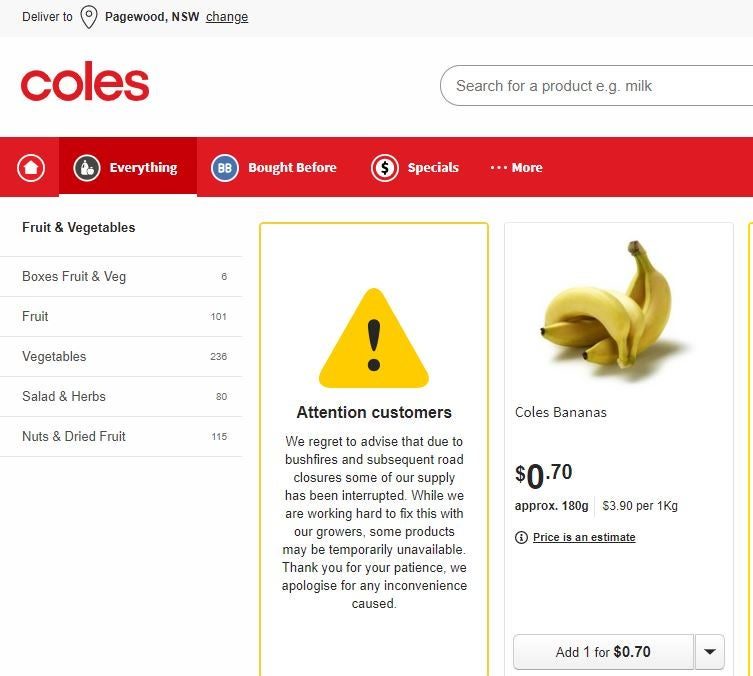The ongoing bushfires that have been ravaging the country since September 2019 - combined with a prolonged and severe drought in many areas - have weighed heavily on farmers and the delivery of fresh food and will result in short-term price increases on fruit and vegetables, according to vegetable industry association AUSVEG.
In fact, people who shop for their groceries online with Coles may have already noticed some items are unavailable due to "bushfires and subsequent road closures".
Industry experts and the government have said that in addition to fruit and vegetables, a number of other products such as honey, milk, wine and meat could go up in price as well.
And it doesn't come at a great time, given people are feeling less motivated to spend while their fellow Australians are suffering, according to AMP Capital Chief Economist Shane Oliver.
"The constant terrible news since October about the bushfires along with the smoke in cities is likely weighing further on the national psyche adding to weakness in consumer spending," Dr Oliver said earlier this month in an analysis of the bushfires' impact on the Australian economy.
Wild weather events have continued since he made that point, with widespread rainfall giving the fireys some reprieve, but also bringing massive hail, floods and dust storms.
AUSVEG and other groups have urged Australians who can afford to do so to keep buying produce to support farmers and regional communities in their recovery from these events. The Australian Government has so far made grants of up to $75,000 available for farmers and other primary producers who have been impacted by the fires.
Food prices expected to rise from the bushfires
Pretty much every vegetable
According to AUSVEG, fresh vegetable prices could rise by between 20% to 50%, and "pretty well anything" could be impacted, including cauliflower, spinach, rocket, broccoli, potatoes and pumpkins.
Honey
Beekeepers have reported that large numbers of vital flowering trees have been wiped out in the bushfires, while the NSW Apiarists Association said 6,000 hives and 30,000 field-bee hives had been destroyed, meaning honey supply from the largest-producing state in the country may be lower than usual.
Milk
Supermarket giants Woolworths and Coles have been pressured by Agriculture Minister Bridget McKenzie to increase milk prices for consumers and pass on the extra money to dairy farmers who have suffered through drought and bushfires.
Woolworths said it is still assessing the situation on the ground, while Coles said it was already paying many of its farmers higher prices without making any change to prices in store.
Wine
In December, fires swept through the Adelaide Hills, which are home to some of the biggest family-owned vineyards in Australia. Adelaide Hills Wine Region said the fires may have wiped out half its annual wine production in the area, valued at $100 million, and it could take up to five years to get things back up and running if grape vines have to be replanted. Meanwhile, growers in NSW's Hunter Valley said smoke could diminish the flavour of future crops.
Meat
According to Meat and Livestock Australia (MLA), close to 80,000 livestock properties have been affected by the bushfires, but the full extent of the damage is still unknown. MLA said about 9% of Australia's cattle herds live in regions that have been significantly damaged under fire, and 13% for sheep.
Beef prices are already expected to increase over the coming year, partly because of African swine fever, which has increased global demand for all meat proteins as a substitute for pork, and also because of the impacts of the drought on Australian cattle herds. This was revealed in economic analysis by IBISWorld, whose analysts also expect pork prices to increase globally as China could lose as much as half its pork supply to the swine flu virus outbreak devastating pig herds across a number of countries in Asia, Africa and Europe.
Financial fallout from bushfires more than just pricey fruit and veg
The financial fallout from the bushfires is clearly adding up. Along with food prices, experts have predicted insurance premiums, tourism and GDP could all be impacted.
The Insurance Council of Australia (ICA) said earlier this month that 8,985 insurance claims had been lodged so far as a result of the bushfires burning since September, with claim numbers only expected to rise.
Comment: The bill for this weeks hailstorm soars to $320million as 29,000 Aussies make claims - but insurers expect thousands more as they dub extreme weather event a 'catastrophe' reports the Daily Mail.
Financial research house Moody's said the scale of claims would be "manageable" for the industry, but that catastrophic fires like these highlight how insurers are exposed to the economic consequences of climate change.
Recent Canstar analysis of the changes in insurance pricing after cyclones in North Queensland suggested premium increases following a natural disaster would be almost inevitable, because insurers are forced to take on more risk. But the ICA has assured affected communities that insurers are prepared and any change in premiums after these bushfires would likely be insignificant.
Dr Oliver said he expected there would also be a strain on tourism from overseas visitors for the next year or so due to "ridiculous maps" widely distributed across social media that have misrepresented the amount of Australia that's actually on fire.
He has also forecast GDP to take a hit of around 0.4% (but worst case 1%) in the March quarter, predominantly due to the bushfires, which are predicted to keep burning for months yet.




Comment: See also: